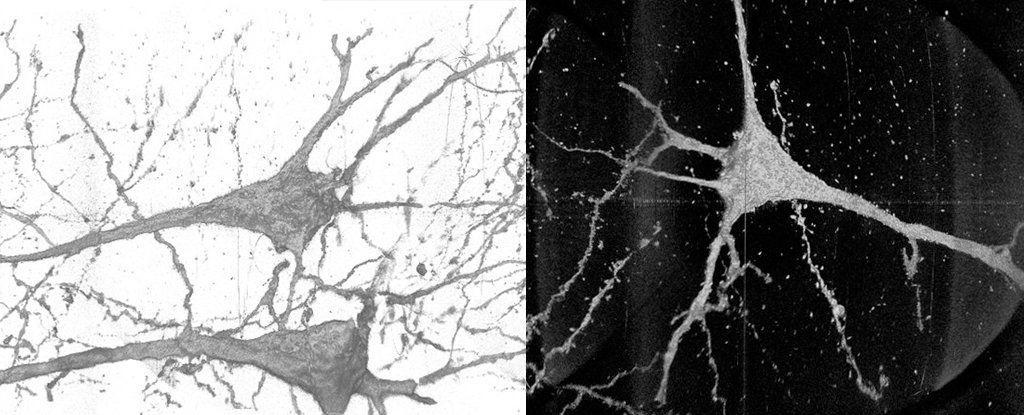
By capturing details of brain cells at the nanometer scale, researchers have found evidence that the neurons of people with schizophrenia may have unique differences in thickness and curvature, and this could even explain some of their symptoms.
The finding comes from an analysis of just a handful of donors, and is far from showing how contrasting nerve cell structures could explain the neurological condition.
But as our understanding of these unusual features grows, it could lead to better treatment methods, giving tens of millions of people around the world a better quality of life.
The study, led by researchers at Tokai University in Japan, used two different X-ray microscope technologies, one at the SPring-8 light source facility in Japan, the other at the U.S. Department of Energy’s Advanced Photon Source (APS).
Both accelerate particles along curved paths in what is known as a synchrotron, giving off short wavelengths of electromagnetic radiation in the X-ray portion of the spectrum.
Using X-rays as a radiation source for photographing fine details of small objects – such as neurons – can be a bit of a double-edged sword.
On the one hand, their tight wavelengths are just what they need to catch every buckle and weave of a cell’s membrane. The APS is capable of a resolution of up to 10 nanometers, a scale that is remarkably close to revealing the texture of individual protein channels traversing a cell membrane.
Viewed from sufficient angles, it is possible to reconstruct neurons as three-dimensional, high-definition terrains.
Unfortunately, as small as neurons are, they are also quite long. Tracing every bump off their surface is tedious work when you have to work your way down whole millimeters of their body.
“The sample has to pass through the X-ray beam to trace the neurons through the sample,” said Vincent De Andrade, a physicist in Argonne’s X-ray Science division.
“The field of view of our X-ray microscope is about 50 microns, about the width of a human hair, and you have to track these neurons a few millimeters.”
By taking tissue samples from a selected area of the brain from four deceased individuals diagnosed with schizophrenia and four without, the team undertook the tedious work of scanning nerve cells using the two different synchrotron facilities.
The images were combined to reconstruct the neurons as digital models, contributing to a larger data set that could be statistically compared and contrasted in search of distinctive features.
They found, statistically, that the thickness and curvature of cellular features extending from the body of the neuron differed significantly between people with schizophrenia, compared to people without the condition.
These variations can affect the way the neurons send messages about their height, which may explain the features of the condition, which in its most severe forms includes hallucinations, impaired motor control and delusions.
Exactly what is behind such anomalies in cellular geometry, or whether the variations extend all the way to the synaptic ‘toes’ of the neuron, requires even more detail than the current generation of synchrotrons can handle.
That could change when the APS gets a US $ 815 million upgrade over the next few years, meaning it will produce far X-rays that are 500 times brighter than those it currently emits.
“The APS upgrade provides better sensitivity and resolution for imaging, making the process of mapping neurons in the brain faster and more accurate,” says De Andrade.
“We would need resolutions better than 10 nanometers to capture synaptic connections, which is the holy grail for comprehensive mapping of neurons, and those should be feasible with the upgrade.”
Putting together the mechanisms behind the development of schizophrenia is a complex process that requires advanced imaging and computer technology.
We gradually begin to understand the multitude of genetic and environmental factors that see the brain change while still in the womb, and continue to shift as a child matures.
If there are ways in which this can be noticed and treated early on, we can help mitigate, if not prevent, the worst traits that can put people at risk for serious mental illness.
This research is published in Translational Psychiatry